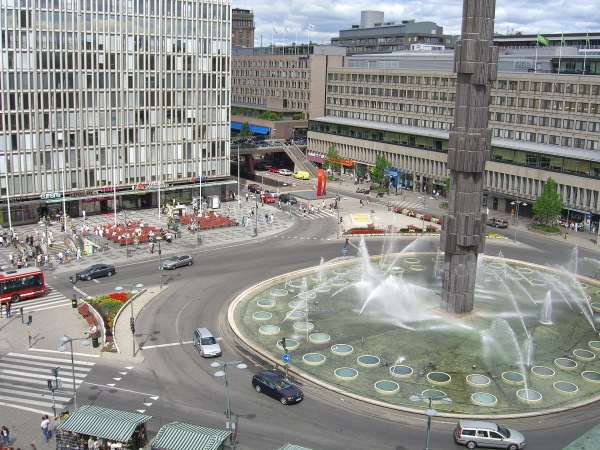
Sergels torg, Stockholm, Sweden. Photo via Wikipedia.
The fountain in Sergels torg (English: Sergel’s Square) in Sockholm is in the shape of a “superellipse.” Piet Hein proposed this shape as a practical and aesthetically pleasing compromise between a circle and a rectangle.
What Piet Hein dubbed a superellipse is a curve satisfying
In the case of Sergels torg, a/b = 6/5. A superellipse is what an analyst would call an Lp ball with p = 2.5 and rescaled axes.
Incidentally, I used curves of this form in a dose-finding method a few years ago. A clinical trial design would pick a, b, and p to match a physician’s desired trade-off between probability of efficacy and probability of toxicity.
Update: A few minutes after I posted this, I realized that there was a bowl on my desk shaped like a superellipse:

The bowl came from Ikea, so there’s another connection to Sweden.
Related post: Volumes of Lp balls

WHAT LOVE IS LIKE
Love is like
a pineapple,
sweet and
undefinable.
Hein also made very good poems/gooks http://www.leptonica.com/cachedpages/grooks/grooks.html
Just a nitpick: according to Wikipedia, a superellipse is more general than that: the exponent doesn’t have to be 2.5 (but it still is an L^p ball and rescaled axes, only with p = n). For example, the squircle is a superellipse with n = 4 and a = b.
off-topic: is math markup parsed in the comments? If so, you could add it to the “You may use these HTML tags and attributes:” text that shows up below the comment box.
I see lots of references to Sweden, but no mention of the fact that Piet Hein was Danish :)
Around here (Denmark), the “superellipse” word is near-synonymous with Piet Hein’s table:
http://www.furnituredesign24.com/furniture/bruno-mathsson/superellipse-table.jpg
If memory serves, a superellipse can be stably stood on any of its four sides.
@Tom Hendrix: Memory does serve: Long ago I turned some super-elllipsoid eggs on a lathe to have fun with the ability to stand them on end.